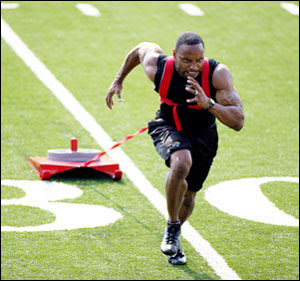There are three fundamental types of exercise that are important for any successful strength and conditioning program. These are the squat, the press, and the pull. The squat develops the ability to exert force against the ground, conditions the trunk and lower body, and has a great deal of transfer to most athletics. The press trains the muscles on the front of the upper body as well as the triceps. Pulls develop the muscles on the back of the upper body and well as the hamstrings and glutes which are key to most athletic activities.
These three types of exercises need to be the foundation of any strength training program for athletes. Each of these exercises develops the body in a manner similar to how it is used in sports. Each is a multi-joint exercise, this means it has a large training effect on the body. Each exercise develops muscle mass effectively. In addition, each exercise allows the athlete to become extremely strong. Between the three, the entire body is trained. Now, other exercises can (and should) be included, but the bulk of the time needs to be spent on these three. There are a huge number of variations of these exercises that are possible, one can train these three movements for years and never get bored. For example:
- Pulls: cleans, snatches, clean/snatch pulls, bent over rows, pull-ups, deadlifts, Romanian deadlifts, good mornings, etc.
- Squats: back squats, front squats, split squats, pause squats, eccentric squats, squats with bands, squats with chains, overhead squats, etc.
- Presses: bench press, incline press, decline press, military press, dumbbell presses, etc.
After these exercises have been factored in, additional exercises can be incorporated to address areas that the coach wants to address. Following are some examples of using these three movements in two-, three-, and four day per week programs.
Two days per week
Day One:
Power clean, 3x3x70%
Back squats, 5×8-12×70-80%
Bench press, 5×8-12×70-80%
Pull-ups, 3×8-12
Day Two:
Front squats, 3×6-10×70-80%
Romanian deadlifts, 3×8-12
Incline press, 3×6-10×70-80%
3-way shoulders, 3x (10 front raises, 10 side raises, 10 rear deltoid raises)
Biceps/triceps, 3×12-15
Three days per week
Day One:
Power clean, 3x3x70%
Back squats, 5×8-12×70-80%
Bench press, 5×8-12×70-80%
Pull-ups, 3×8-12
Day Two:
Front squats, 3×6-10×70-80%
Romanian deadlifts, 3×8-12
Standing military press, 3×8-12
Biceps/triceps, 3×12-15
Day Three:
Split squats, 3×8-12 each leg
Partial deadlifts, 3×4-8
Incline press, 3×8-12×70-80%
3-in-1 shoulders, 3x (10 front raises, 10 side raises, 10 rear deltoid raises)
Four days per week
Day One:
Power clean, 3x3x70%
Back squats, 5×8-12×70-80%
Lunges, 3×8-12 each leg
Romanian deadlifts, 3×8-12
Day Two:
Bench press, 5×8-12×70-80%
Dumbbell incline press, 3×12-15
Pull-ups, 3×12-15
One-arm dumbbell rows, 3×8-12 each arm
Biceps/triceps, 3×12-15
Day Three:
Power snatch, 3x3x70%
Front squats, 3×6-10×70-80%
Good mornings, 3×8-12
Glute ham raises, 3×12-15
Day Four:
Incline press, 3×8-12×70-80%
Bent over rows, 3×8-12
Seated rows, 3×12-15
Standing military press, 3×8-12
3-in-1 shoulders, 3x (10 front raises, 10 side raises, 10 rear deltoid raises)
No matter how many days of week the athlete trains, the workouts are focused around squatting, pressing, and pulling. Even at four days/week, the athlete is still performing these exercises. The more training sessions per week, the more assistance work can be incorporated (for example, there are 19 exercise performed when training four days per week versus 10 for two days).

